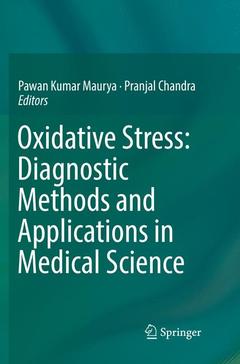Description
Oxidative Stress: Diagnostic Methods and Applications in Medical Science, Softcover reprint of the original 1st ed. 2017
Coordinators: Maurya Pawan Kumar, Chandra Pranjal
Language: English
Subjects for Oxidative Stress: Diagnostic Methods and Applications in...:
Publication date: 12-2018
Support: Print on demand
Publication date: 11-2017
Support: Print on demand
Description
/li>Contents
/li>Biography
/li>Comment
/li>
This book discusses the importance of oxidative stress, related biomarkers, and its diagnostic methods including bio-analytical and advanced detection systems.
Oxidative stress is associated with diminished capacity of a biological system to overcome the overproduction of reactive oxygen species. Since oxidative stress has been suggested as a causative factor in many diseases, its prevention is vital, and there is an urgent need for oxidative stress monitoring using in vitro and in vivo models. Interdisciplinary approaches have lead to the development of various oxidative stress monitoring models for real-world clinical and biomedical applications. The development of such methods requires a broad understanding of biology, chemistry, molecular biology, immunology and microbiology. As such, the book is a valuable resource for students, researchers and clinicians interested in the fundamental as well as applied aspects of oxidative stress associated diseases.
- Introduction
1.1 Free radicals and reactive oxygen species (ROS)/reactive nitrogen species (RNS)
1.2
1.3 Redox potential and protection against oxidative stress
1.4 Oxidative stress and diseases
- Importance of oxidative stress monitoring
- Oxidative stress monitoring using in vitro models
3.2 Oxidative stress monitoring using blood samples
3.3 Oxidative stress monitoring using other biological samples
- Oxidative stress monitoring using in vivo models
4.1 Oxidative stress monitoring using transgenic mouse model
4.2 Oxidative stress monitoring using Zebra fish
4.3 Oxidative stress monitoring using other biological in vivo models
- Detection of oxidative stress biomarkers using biosensors
5.1 Concept and principle of biosensors
5.2 Gold nanoparticle based colorimetric methods for biomarkers of oxidative stress
5.3 Biosensor for in vitro detection of cancer and bacterial cells
5.4 Detection of neurotransmitters, DNA, Proteins etc.
5.5 Biosensors for online monitoring
5.6 Microsensor arrays
6. Future prospects and challenges
Dr. Pawan Kumar Maurya is currently employed as Assistant Professor at Amity Institute of Biotechnology, Amity University Noida, India. He has done a Ph.D. from the University of Allahabad (A Central University), India & post-doctoral training from Universidade Federal de Sao Paulo-UNIFESP, Brazil, Taipei Medical University (TMU) and National Taiwan University (NTU), Taiwan. He is working on Biochemical diagnostics, nanomedicine, and clinical biochemistry. He has published over 48 research articles in reputed journals. He is recipient of prestigious fellowship: Science without Borders (Government of Brazil).
Dr. Pranjal Chandra is currently employed as Assistant Professor and principal investigator at Department of Biosciences and Bioengineering, Indian Institute of Technology Guwahati, Assam, India. He earned his Ph.D. from Pusan National University, South Korea and did post-doctoral training at Technion-Israel Institute of Technology, Israel. He has published over 50 research articles in reputed journals and 1 book (IET, United Kingdom). He is also a visiting scientist at IBST, South Korea. Pranjal's research contributions are highly interdisciplinary, spanning a wide range in nanobiotechnology, nanobiosensors, lab-on-chip systems for biomedical diagnostics, and nanomedicine. His work has been highlighted in the World news of Royal Society of Chemistry, Cambridge as "A new system for cancer detection” and also featured as a key scientific article in the Global Medical Discovery news Canada. He is recipient of many prestigious awards and fellowships such as; Ramanujan fellowship (Government of India), BK -21 and NRF fellowship of South Korea, Technion post-doctoral fellowship, Israel, University of Montreal Post-doc fellowship, Canada, NMS Young scientist Award etc. He is also editorial board member of a dozen international journals including; World journal of methodology, USA; Frontiers of Biosciences, USA; Journal of Biosensors and Bioelec
This book covers the basics of oxidative stress monitoring in the laboratory as well as it's commercial aspects
The novel design aspect of diagnostics keeping the clinical viability of oxidative stress monitoring is highlighted in this book
It provides new insight into how oxidative stress damages biomolecules and plays role in disease progression
It also talks about most recent diagnostic methods such as nanosensors




